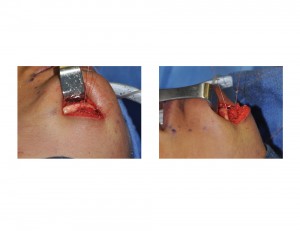The number of different procedures available for correction of chin ptosis (chin pad ptosis) indicates that there is no one single procedure that works the best. While chin ptosis correction techniques vary, it is important to appreciate that there are different anatomic variants of chin ptosis. There are contributions of bone, skin and fat, mentalis muscle and lower lip positioning. Together these create different types of chin ptosis problems.
In Volume 3 Number 2 2012 issue of Plastic Surgery Pulse News, an article appeared entitled ‘A Novel Correction of Chin Ptosis By Vertical Wedge Excision of Subcutaneous Soft Tissue’. Using a single patient example, the authors describe a vertical midline wedge excision of soft tissue. In this technique the vertical laxity of the ptotic chin pad is tightening along the inferior border of the chin mental border while correcting the horizontal tissue laxity as well. The technique also improves anterior chin projection and softens the labiomental crease as well. This vertical wedge of mentalis and soft tissue when brought together creates a clothesline effect that helps reposition and suspend the ptotic tissues up over the lower anterior border of the mandibular symphysis. In the process, the soft tissues of the chin pad are rotated upward, augmenting the anterior chin and re-creating the labiomental fold. Any excess skin and subcutaneous fat is then trimmed in a horizontal fashion in the submental region.

Chin ptosis is a multifactoral problem that has different anatomic variants. The first important classification is whether the chin ptosis is associated with a lower lip sag or not. If there is no lower lip sag there is no benefit to mentalis muscle resuspension or trying to move the chin tissues back upon the one. The next important chin ptosis classification is whether there is excessive chin tissues or whether there is a normal amount of tissue volume. If the overhanging chin tissues are normal in volume, and their resection may be associated with causing a lower lip sag, then resuspension should be done. When the ptosis is caused by excessive chin tissues then resection would be the appropriate approach.
When it comes to resection of the chin pad, it can be done horizontally (under the chin), vertically (as shown in the article) or through a combined vertical and horizontal technique. (inverted T) There is no question that adding a vertical direction to the chin pad excision provides an additional element of chin pad reduction that is helpful.
Dr. Barry Eppley
Indianapolis, Indiana


